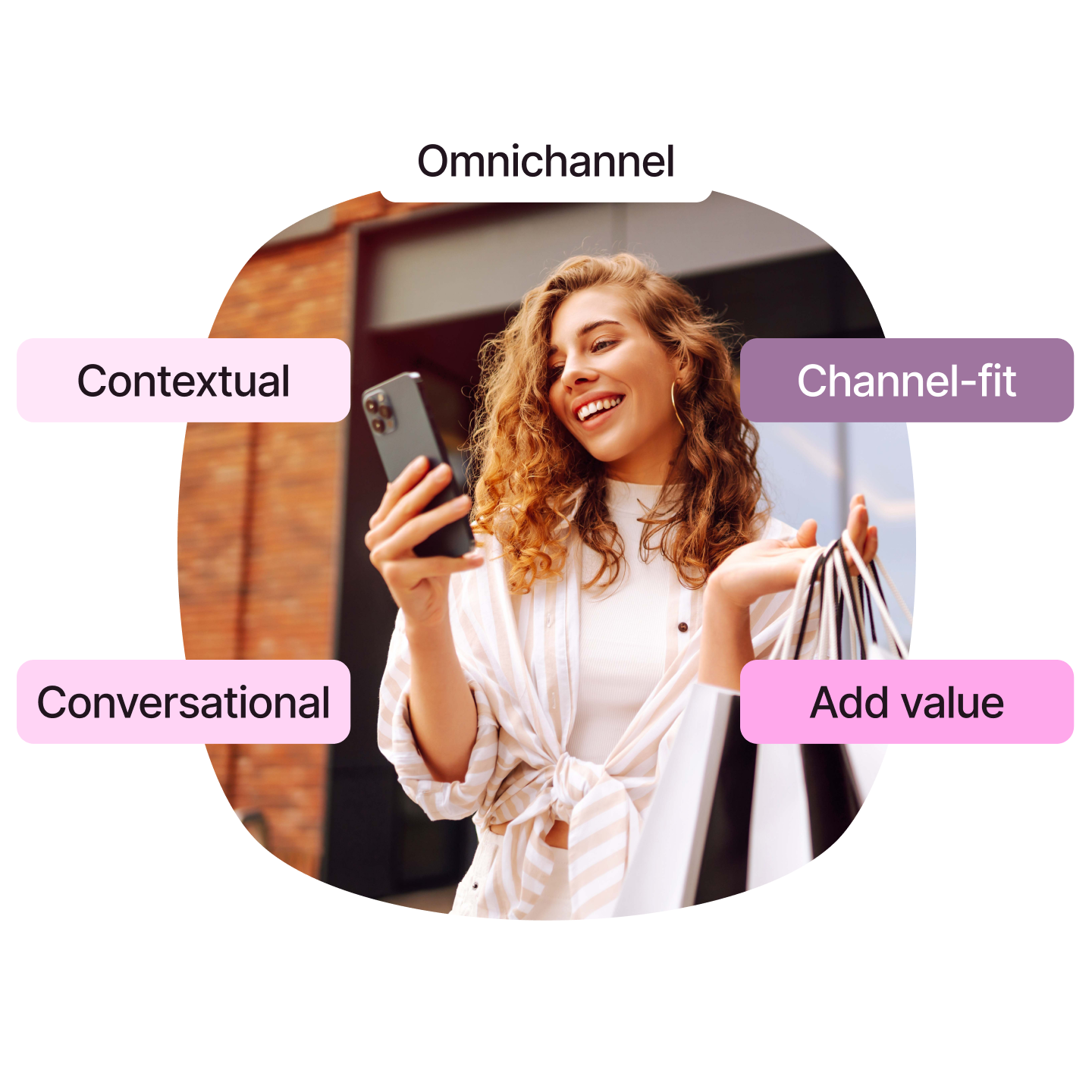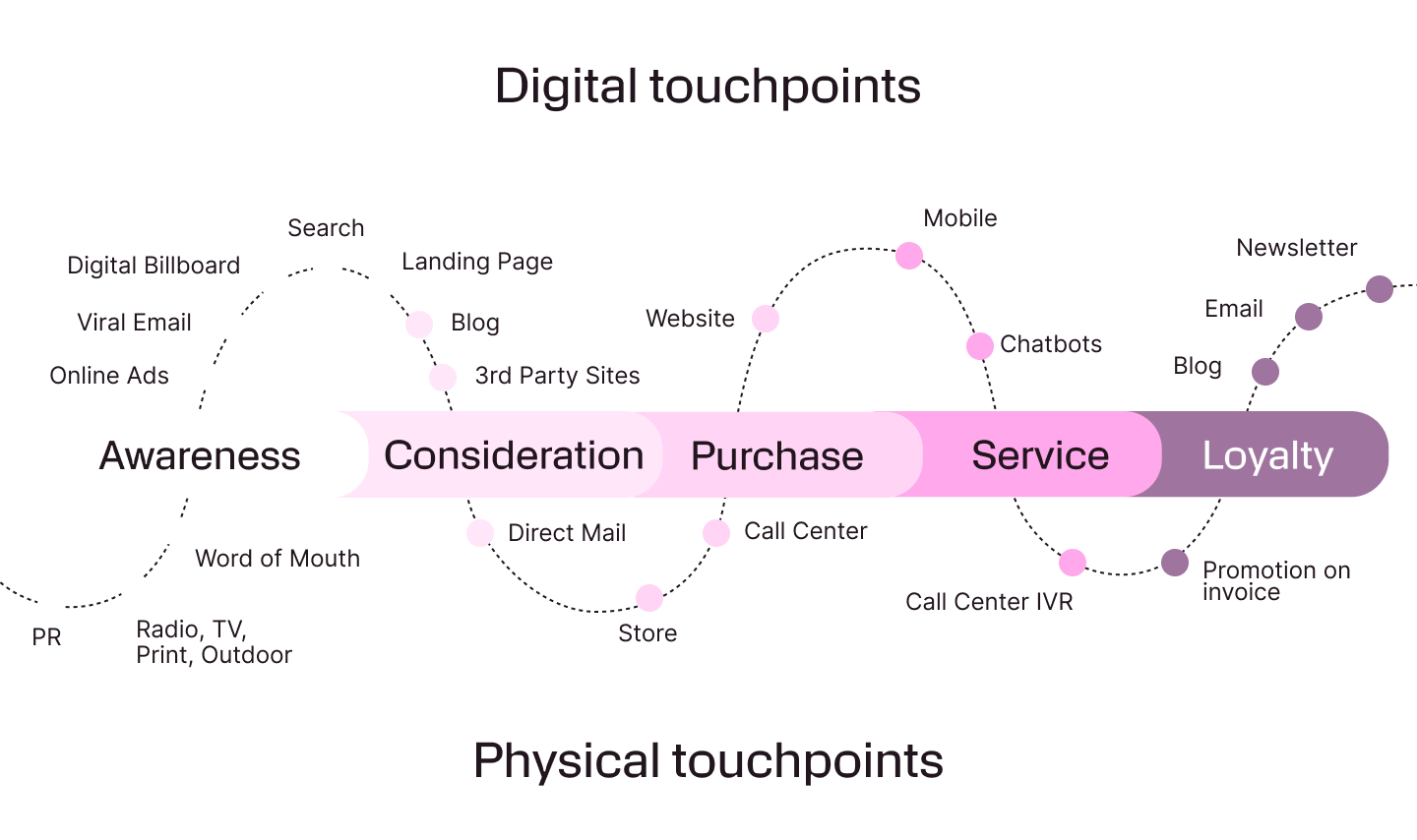Optimizing retail touchpoints for elevated customer journeys
Unlock ways to optimize your retail touchpoints to offer better customer journeys and drive business results.

Every time a customer interacts with your brand, whether it’s on your website, through an app, or via social media, that moment matters. These interactions, known as retail touchpoints, collectively shape the customer journey and have a direct impact on satisfaction, loyalty, and revenue.
The modern customer demands digital and user-friendly interactions with little tolerance for pain points. In fact, 86% of customers will leave after two bad experiences with a brand.
No matter how strong your product is, the quality of each interaction ultimately defines your customer experience. Every interaction contributes to the customer’s impression of your brand and their overall experience while shopping with you.
Meaning, each touchpoint matters.
The key is to identify and optimize them to meet the expectations of your customers, and in turn, you can boost conversions and improve your bottom line.
What is a customer touchpoint?
A customer touchpoint is an interaction between a customer and your brand that influences their perception of you. This can be anything from seeing an advertisement to speaking with customer support or downloading your app.
These touchpoints are mapped out throughout the customer journey and provide insight into how customers interact with your business. Each touchpoint offers retailers a chance to impress and satisfy customers, improving their overall experience.
Now that we’ve defined them, let’s explore where these touchpoints typically appear along the customer journey.
Examples of retail touchpoints
Touchpoints exist in every stage of the customer journey. From pre-purchase to post-purchase, every interaction will determine if customers feel satisfied enough to purchase from you again.
Map out all the interactions customers have with your brand to determine if those touchpoints add value to the relationship or have developed into pain points.
Each of these interactions is a chance to reinforce your brand, remove friction, and deliver meaningful value.
Here are some typical touchpoints for retail:
| Pre-purchase | During purchase | Post-purchase |
|---|---|---|
| Social media posts | Account signup | Re-engagement messages |
| Ads and influencer content | Website or app browsing | Delivery updates |
| Blog content | Checkout process | Feedback surveys |
| Online reviews | Customer support | Returns and exchanges |
| Word of mouth | In-store assistance | Loyalty programs |
Identifying the right touchpoints is the first step to optimizing them. Here’s how to find what matters most.
How to identify touchpoints in retail?
Put yourself in the customer’s shoes and find every point of contact they have with your brand across channels. You can use feedback surveys and reviews to determine the emotions associated with each touchpoint and find pain points you didn’t know existed.
Take Petpetgo, for example.
The eCommerce retailer found that Facebook ads and generalized email campaigns resulted in low return on advertising spend (ROAS). These touchpoints were not adding value to their potential and existing customers, which meant their bottom line was suffering.
After auditing their retail touchpoints, they realized these channels weren’t driving engagement or value. By shifting to a personalized, omnichannel messaging strategy, they doubled purchase frequency and reduced ad spend by 10%.
Infobip tip: Optimize underperforming touchpoints by making them more contextual, timely, and personalized.
Evaluate your touchpoint readiness with Infobip’s CX Maturity Assessment
Before optimizing your retail touchpoints, it’s important to understand where your business currently stands. Are your channels connected? Are you delivering a consistent, personalized experience at every step of the customer journey?
Infobip’s CX Maturity Assessment helps you evaluate how advanced your current setup is in managing retail touchpoints and delivering a seamless customer experience.
This quick, guided assessment benchmarks your business across four dimensions:
- Channel coverage: Are you engaging customers where they prefer to interact (e.g., social media, messaging apps, email)?
- Customer insight: Do you have the data to understand how each customer interacts with your brand?
- Journey orchestration: Can you deliver the right message, on the right channel, at the right time?
- CX agility: How quickly can you adapt and optimize your communication strategies?
Whether you’re just getting started or ready to scale with automation and personalization, the assessment gives you a clear view of your strengths and opportunities and guides you toward the next level of customer experience excellence.
5 messaging techniques to improve retail touchpoints
Relevant messaging plays a huge role in the success of transforming touchpoints into seamless experiences, much like in Petpetgo’s case.
These five techniques help you turn each touchpoint into a moment of value.

1. Prioritize omnichannel and timely communication
Customers don’t want to repeat themselves across channels. A connected, omnichannel experience helps unify conversations and data, ensuring each customer interaction feels consistent and frictionless. Use customer preferences and activity data to send messages at the right time, on the right channel.
2. Make messages contextual and behavior-based
A generic message is easily ignored.
Make your communication touchpoints behavior or event-driven, and always have something relevant to say to your customers. A personal touch is also the perfect way to re-engage customers who may be on the fence, seem disengaged, or have shown any periods of inactivity. What’s more, compelling, personalized offers and incentives get attention and stand out above all other types of generic digital noise.
3. Keep it conversational
Ultimately, customers respond best to human-to-human communication, which is at the heart of conversational and meaningful interactions. But artificial intelligence and digital apps play a major role in enabling brands to achieve a conversational customer journey.
Using seamless CRM, customer service integrations, chatbots, and a range of messaging apps allows instant, interactive, and more personable communication between brands and customers – a recipe for customer satisfaction and overall better touchpoints.
4. Make sure your messages fit the style of the channel
When messaging customers via apps like Viber and WhatsApp, you need to fit in with the other messages they will receive on those channels. Most of their contacts are likely family and friends, so if you send a formal business message or a flashy advertisement, it could be seen as invasive and spammy and get ignored.
You must be prepared to interact with your customers how, where, and whenever they choose. If you keep your communication strategy conversational and natural, sending relevant and personalized messages at the right moment, you’re sure to see better results.
Leverage the likes of mobile app messages, chat apps, and RCS to embed clickable buttons that ensure customers can reply easily and quickly. If you want your customers to participate in touchpoints, you need to make it as easy and painless as possible for them to comply.
5. Always add value
Great customer messaging touchpoints always add value. When you have a customer’s contact details, don’t take advantage of that to send a stream of ads or reminders to visit your website.
Your messages should offer something that makes your customer’s life easier and happier.
Where possible, always give your customers options – people love the freedom to choose. Provide helpful and exciting content customized to suit their interests and preferences.
Optimizing key retail touchpoints across the customer journey
Learning where and how to apply these essentials can make or break your touchpoints. But they allow you to optimize your interactions and improve the overall experience.
Of course, there are some touchpoints that you can’t directly optimize, such as word of mouth or customer reviews. But with time and determination, customer satisfaction scores will go up, leading to better experiences and more positive reviews.
Before we dive into specific pre-, during-, and post-purchase optimizations, let’s look at how different types of touchpoints (owned, paid, and earned) typically appear across the retail journey:
| Stage | Owned | Paid | Earned |
|---|---|---|---|
| Pre-purchase | Blog, app | Social ads | Reviews, referrals |
| Purchase | Website, support | Sponsored search | Product mentions |
| Post-purchase | Email, chatbot | Retargeting ads | UGC, feedback |
This table can help you identify where your current efforts are focused and where you may have gaps. A balanced strategy includes all three channel types, supporting a seamless and omnichannel customer experience.

Now, let’s break down ways to optimize important retail touchpoints throughout the customer journey to improve the overall customer experience:
Pre-purchase touchpoints
Social media
- Make sure everything your customers need to know is readily available, up to date, and accessible on your social pages.
- Use metrics to determine which posts perform the best and lead to conversions.
- Create a strategy around your customers’ behavior and leave them with a great impression after viewing your social page.
87%
of online shoppers use social media while shopping for products
Infobip tip for social media:
Remove the need to switch between apps. If a customer is browsing your Instagram and sees a product they like, allow them to message your brand directly to ask questions before purchasing the product. The rise of social commerce is not slowing down. Gartner predicts that 60% of millennials will prefer to make purchases on their favorite social platforms over traditional eCommerce sites. Give them a simpler and faster way to purchase products, adding value to the entire interaction.
Advertisements
Similar to social media, metrics are key.
- Use performance metrics to determine which ads get the most interactions and drive the highest conversions.
- Identify which campaigns resonate with your target audience and refine the ones that miss the mark.
- Focus on relevance. Ensure your ads are timely, personalized, and aligned with your customer’s interests.
Infobip tip for advertisements:
Relevance is essential since the modern online shopper expects brands to know what is relevant to them and get irritated with content that doesn’t carry meaning. A customer data platform can help you gather data on your customers and segment them based on their interests, allowing you to send targeted campaigns to the right customers.
Blog
- Use blogs to educate customers about your products, services, and related topics they value.
- Link to relevant products within blog content to support discovery and boost conversions.
- Develop content around customer interests, such as beauty, health, or lifestyle, based on your industry.
Infobip tip for blogs:
Learn about your customer’s intent to make this touchpoint count. Why are they visiting your blog, and what do they hope to learn from it? SEO research can go a long way in ensuring you write content with the right intent that interests your audience, adding value to their interaction with you.
Account signup
- Streamline the signup and login process to reduce friction and avoid drop-offs.
- Identify common points of frustration during account creation and look for ways to improve them.
- Offer incentives to encourage customers to create a profile, such as discounts, loyalty points, or early access to new products.
Infobip tip for account signup:
If you’ve been collecting and segmenting data on your customers, you have insight into which communication channels they prefer to use and which devices they use to shop. Send verification messages or codes over their favorite channel to make the login process as simple as possible.
During purchase touchpoints
Web and app
- Ensure your website and app offer a seamless, user-friendly experience from download to checkout.
- Identify friction points in browsing or navigation that may prevent customers from completing a purchase.
- Optimize performance across devices and personalize the interface based on customer behavior and preferences.
Infobip tip for web and apps:
Send push notifications based on their browsing history. Send them relevant discounts on products they viewed, enticing them to reopen the app and complete the purchase. Adding a touchpoint like this can improve sales and add relevance to your engagement.
Customer support
- Provide responsive, multichannel support to avoid long queues and boost satisfaction.
- Equip your agents with context about each customer interaction for faster issue resolution.
- Make it easy for customers to reach you, wherever they are and whenever they need help.
Infobip tip for customer support:
Add a chatbot to your customer support team and a cloud contact center solution for optimized performance from service agents. Your brand can interact with customers on their favorite channels by adding a chatbot. With natural language processing (NLP) technology, chatbots can provide a real conversational experience, speed up resolution time and ensure customers are left satisfied.
Checkout
- Simplify the checkout process to reduce abandonment by minimizing the number of steps and input fields.
- Offer flexible payment options and guest checkout for ease and speed.
- Ensure mobile optimization, as many customers complete purchases on their phones.
Infobip tip for checkout:
Once the order has been placed, avoid sending order confirmations over email. Instead, send it over WhatsApp, Viber, or whatever communication channel they prefer. This way, you can ensure it does not get lost in promotional inboxes and customers get automatic assurance their purchase is on the way.
Post-purchase touchpoints
Billing
- Send billing receipts and order confirmations instantly to maintain trust and transparency.
- Make invoices easily accessible and downloadable across devices.
- Ensure billing communication is clear, accurate, and secure.
Infobip tip for billing:
Use rich messaging (RCS) to elevate this touchpoint. You can send branded messages to customers with PDF documents of their receipts and bills, ensuring they can trust your brand and that they won’t overlook the message.
Delivery
- Keep customers informed about order status with real-time delivery updates.
- Notify them proactively about any delays or changes, don’t wait for them to ask.
- Enable tracking and self-service options to reduce frustration and support load.
Infobip tip for delivery:
You can optimize this touchpoint by allowing two-way communication over channels such as WhatsApp or Messenger. Let customers track their purchases and resolve their questions quickly over these chat apps. This will allow you to smooth any pain points during the delivery process and leaves a positive impression on your brand.
Feedback
- Collect feedback right after a purchase or support interaction while the experience is still fresh.
- Use short, actionable surveys to capture key insights without overwhelming customers.
- Show that you value feedback by acting on it and communicating improvements.
Infobip tip for feedback collection:
Make it even easier for customers to give feedback with call-to-action buttons or by prompting simple replies in chat apps. Remove the need to switch pages and complete a survey online and provide them with an easier way to give you valuable feedback.
Returns
- Simplify return and exchange processes to maintain trust even after a product doesn’t work out.
- Allow customers to initiate returns on their preferred channel with minimal effort.
- Be transparent about return policies and timelines upfront.
Infobip tip for returns and exchanges:
Allow customers to request return tickets over any channel and provide them with the documents they need right in the app. This will ensure customers can quickly access what they need and leave them satisfied with your brand, even if they weren’t 100% satisfied with the product.
Re-engagement
- Send relevant, personalized content to re-engage inactive or one-time customers.
- Use behavior and location data to offer tailored promotions at the right time.
- Deliver messages on the channels where each customer is most likely to respond.
Infobip tip for re-engagement:
With an omnichannel solution, you can use geo-targeting to send customers relevant deals based on where they are. When they are close to your retail store, send them special deals available only when they come to shop in your store. Draw their attention and get them to participate in a physical touchpoint with your brand using digital interactions.
Create customer-centric retail touchpoints
Your customer experience is only as strong as your weakest touchpoint. By identifying gaps, using omnichannel strategies, and applying personalized messaging tactics, you can turn everyday customer interactions into lasting brand moments. By following these tips and practicing proactive outreach, you can create memorable experiences for your customers, with their needs center focused. You will build painless touchpoints and strong relationships that keep them coming back for more.
Related content:

How to make AI shopping assistants your brand ambassadors.
Learn how AI shopping assistants are transforming the retail landscape, driven by the need for exceptional customer experiences in an era where every interaction matters.
- Blog.
- Conversational experience.
- eCommerce.
- Retail.
- Best Practices.

The complete guide to retail customer engagement.
Win your customers’ hearts! Learn about customer engagement in retail and how to build the ideal customer engagement strategies for your business.
- Blog.
- Marketing.
- Retail.
- Best Practices.

Make every season count: A strategic guide to seasonal marketing.
Learn how to create compelling marketing campaigns that resonate with your audience, regardless of the season.
- Marketing.
- Best Practices.

Cart abandonment: 11 proven strategies for eCommerce success.
Cart abandonment is a major challenge in eCommerce. This blog breaks down why shoppers leave without buying, and more importantly, what you can do about it.
- eCommerce.
- Best Practices.

SMS marketing benchmarks: Key stats by industry.
Find out how your SMS marketing ranks against the averages for your industry and how you can move the needle to achieve better results.
- Blog.
- SMS.
- Best Practices.

Omnichannel retail strategy for transformed customer experiences.
With the right omnichannel retail strategy, you can personalize every step of the customer journey and create a smoother path to purchase and loyalty. Explore how to make it happen.
- Blog.
- Retail.
- Best Practices.

What is phygital marketing? 11 examples of phygital experiences.
Let's explore everything you need to know about phygital marketing and how it can help you build a successful marketing strategy.
- Blog.
- People CDP – customer data.
- Inspiration.

Retailtainment 101: How to create immersive customer experiences.
Retailtainment helps transform the retail industry from a place of transaction to a hub of experience. Join us as we explore the strategies, examples, and benefits and help you discover how to create an entertainment-rich environment that captivates your customers.
- Retail.
- Retail.
- Awareness.








